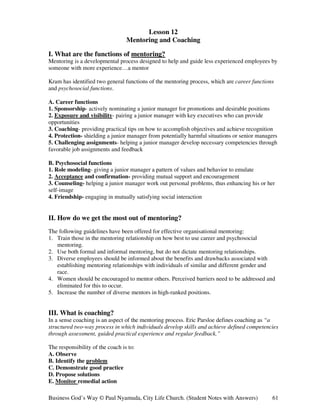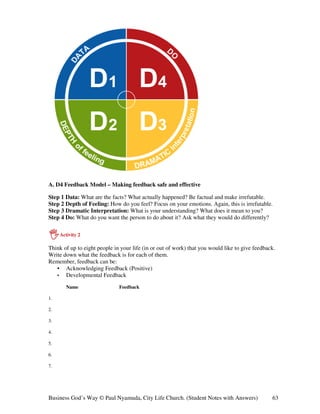Mentoring & Coaching
- 1. Lesson 12 Mentoring and Coaching I. What are the functions of mentoring? Mentoring is a developmental process designed to help and guide less experienced employees by someone with more experience…a mentor Kram has identified two general functions of the mentoring process, which are career functions and psychosocial functions. A. Career functions 1. Sponsorship- actively nominating a junior manager for promotions and desirable positions 2. Exposure and visibility- pairing a junior manager with key executives who can provide opportunities 3. Coaching- providing practical tips on how to accomplish objectives and achieve recognition 4. Protection- shielding a junior manager from potentially harmful situations or senior managers 5. Challenging assignments- helping a junior manager develop necessary competencies through favorable job assignments and feedback B. Psychosocial functions 1. Role modeling- giving a junior manager a pattern of values and behavior to emulate 2. Acceptance and confirmation- providing mutual support and encouragement 3. Counseling- helping a junior manager work out personal problems, thus enhancing his or her self-image 4. Friendship- engaging in mutually satisfying social interaction II. How do we get the most out of mentoring? The following guidelines have been offered for effective organisational mentoring: 1. Train those in the mentoring relationship on how best to use career and psychosocial mentoring. 2. Use both formal and informal mentoring, but do not dictate mentoring relationships. 3. Diverse employees should be informed about the benefits and drawbacks associated with establishing mentoring relationships with individuals of similar and different gender and race. 4. Women should be encouraged to mentor others. Perceived barriers need to be addressed and eliminated for this to occur. 5. Increase the number of diverse mentors in high-ranked positions. III. What is coaching? In a sense coaching is an aspect of the mentoring process. Eric Parsloe defines coaching as “a structured two-way process in which individuals develop skills and achieve defined competencies through assessment, guided practical experience and regular feedback.” The responsibility of the coach is to: A. Observe B. Identify the problem C. Demonstrate good practice D. Propose solutions E. Monitor remedial action Business God’s Way © Paul Nyamuda, City Life Church. (Student Notes with Answers) 61
- 2. Hence, coaching involves helping committed executives achieve their potential, focusing on what they do everyday on the job and practicing new approaches. It means offering a sounding board for executives to try out new ideas. A central aspect of coaching is the art of giving feedback. In the next section we explore the concept of feedback further. IV. How can we give effective feedback in managing performance? In a melting pot of cultures it is interesting to note that countries and national cultures differ in their approach to feedback. In Europe the Dutch and Swedish people are known for their direct approach in willingness to give negative feedback whilst the Japanese tend to very careful about saying anything which can result in someone else feeling embarrassed or lose face. Since we all have varying degrees of comfort with giving or receiving feedback it is important that we look to God’s Word for grounding in this area. Giving and receiving feedback is very biblical. It is clear from scripture that we ought to seek feedback and input from others. The following scriptures highlight this principle: Col 3:16 Let the Word of Christ dwell in you richly in all wisdom, teaching and admonishing one another in psalms and hymns and spiritual songs, singing with grace in your hearts to the Lord. 1 Thess 5:12 And, brothers, we beseech you to know those who labor among you, and are over you in the Lord, and who admonish you, Prov 12:1 Whoever loves instruction loves knowledge; but he who hates correction is like a brute animal. 2 Tim 3:16-17 All Scripture is God-breathed, and is profitable for doctrine, for reproof, for correction, for instruction in righteousness, Gal 6:1 Brothers, if a man is overtaken in a fault, you the spiritual ones restore such a one in the spirit of meekness, considering yourself, lest you also be tempted. Business God’s Way © Paul Nyamuda, City Life Church. (Student Notes with Answers) 62
- 3. A. D4 Feedback Model – Making feedback safe and effective Step 1 Data: What are the facts? What actually happened? Be factual and make irrefutable. Step 2 Depth of Feeling: How do you feel? Focus on your emotions. Again, this is irrefutable. Step 3 Dramatic Interpretation: What is your understanding? What does it mean to you? Step 4 Do: What do you want the person to do about it? Ask what they would do differently? Activity 2 Think of up to eight people in your life (in or out of work) that you would like to give feedback. Write down what the feedback is for each of them. Remember, feedback can be: • Acknowledging Feedback (Positive) • Developmental Feedback Name Feedback 1. 2. 3. 4. 5. 6. 7. Business God’s Way © Paul Nyamuda, City Life Church. (Student Notes with Answers) 63
- 4. B. Understanding whether the feedback that you have mentioned intended to help the person, or to meet your need. Acknowledging Developmental To help them Build their self esteem Support their development To meet my need Reinforce desired Change or ‘correct’ behaviour behaviours How do you think the Feedback you plan to give will be accepted? Especially the Developmental Feedback? C. Understanding the relationship between identity and feedback We naturally tend to associate what we do and say with who we are….with our identity. When my identity is wrapped up in my ‘performance’ or in what I do: 1. I will tend to be perfectionistic and strive, and I will not be at rest and at peace. 2. I may project an image of myself that is not true. 3.Correction, critical appraisal, etc., will be offensive to me. I will tend to take it personally, as a personal affront or as an attack on my identity, and it could even feel like rejection. 4. I may tend be a ‘blank slate’ and not have an opinion of myself and what I say or do before I hear from those I perceive to be in authority. When I hear their feedback, I don’t take it as just that...(their opinion that could be wrong), but I take it as law. Feedback is a very positive thing. I should desire critical appraisal, because this is what will cause me to learn and grow and improve. When I receive critical appraisal, the criticism is not of me, it is of something I said or did, and I am not what I said or did. D. Moving quickly through the five stages in landing feedback. 1. DENIAL – do we actually ‘let it in’? 2. ANGER – with ourselves or with the one giving the feedback 3. RATIONALISATION – seeking to justify and explain 4. ACCEPTANCE – genuinely ‘letting in’ the feedback 5. NEW LEARNING AND CHANGED BEHAVIOUR – consciously and willingly taking action as a result of the feedback E. Learning art of receiving correction and feedback. We can develop the art of receiving feedback by adhering to the following: 1. Listen, listen, listen and try to understand from an objective perspective 2. Try not to explain, defend, deny, etc. 3. Be open to the perception of others (their perception is their reality), but understand that at the end of the day it is their perception only! 4. Ask for clarification, if needed. 5. Receive it and sort through it internally, deciding what is applicable and how it should be applied in future Business God’s Way © Paul Nyamuda, City Life Church. (Student Notes with Answers) 64
- 5. 6. Remember not all feedback is constructive and useful, but we can learn from most things if we want to. F. Creating a culture that values feedback. The following outlines the importance of receiving feedback from subordinates, peers and superiors: 1. For an organisation to breed leaders, it needs to create an environment where individuals are continuously giving and receiving feedback from each other and their environment. 2. Feedback works best when there is already a culture that values feedback. 3. When you look in the mirror, do you see yourself or an ideal image of yourself? It is essential that there is a culture of transparency in our organisations that results in individuals being secure enough to receive negative feedback. 4. In a learning organisation there should be a culture which views negative feedback positively. 5. Negative feedback will highlight points for development. 6. Individuals should be acclimatised to a culture of feedback where they actually look for it and appreciate it when it comes. 7. Critical appraisal given can most often be distilled down to a few manageable themes - it often involves a just few root issues. V. What are the factors influencing the outcome of feedback? Some points to consider: 1. Emotional reactions 2. Inadequate explanation Explain the consequences. What will happen as a result? 3. Overemphasis on the negative Build on the other person’s strengths. It’s easier to swallow a bitter pill if it is coated in honey! 4. Lack of participation 5. The amount of feedback Typically the feedback should include the a) situation, b) their behaviour and c) the impact of their behaviour. Many of us tend to speak in circles to the extent that our hearers feel like their swimming in words. In the end they are confused. 6. The timing of the feedback People often hear feedback at a time when they have other baggage. This obviously affects how they hear and perceive what you are saying. If the feedback came at a different time or context their response would be different. 7. The style How something is stated is very important. Does the feedback emphasize their behaviour, an attitude or the person’s identity? Is an unfair judgment being made? There is a difference between saying, “At the final dress rehearsal you were twenty minutes late for the practice and as a result our practice time was shortened.” OR “You are a bad at time management and don’t respect people.” 8. Positive alternative Our feedback needs to be solution oriented. People don’t just want to know what the problem is but are motivated when they see a way out. 9. Motives In giving feedback the heart is one of trying to help the other person. This should be done in humility being aware of one’s own weaknesses. Business God’s Way © Paul Nyamuda, City Life Church. (Student Notes with Answers) 65
- 6. 10. Trust People are more open to feedback when they trust the source of the feedback. In an environment where there is much competitiveness and suspicion, the vital component, trust can be built up using the following tools: 1. Communication Keeping team members informed. Honesty about one’s own problems and limitations. 2. Support Advice, coaching. 3. Respect Actively listening/delegation. 4. Fairness Objective and impartial appraisal. 5. Predictability Keeping both expressed and implied promises. 6. Competence Trust needs to be earned as opposed to demanded. Bryn Hughes gives us a very user-friendly, easy to remember guideline for giving feedback. Actionable Advice should be practical, realistic and something that can be used Blame free Tough on issues not on people Calm Generally the manner should be cool and not full of emotion Dispassionate Factual and objective Enlightening Don’t tell people what they already know Future-oriented Focus on future not on past to produce change Generous Mix positive and negative feedback; keep to a narrow negative agenda Business God’s Way © Paul Nyamuda, City Life Church. (Student Notes with Answers) 66





